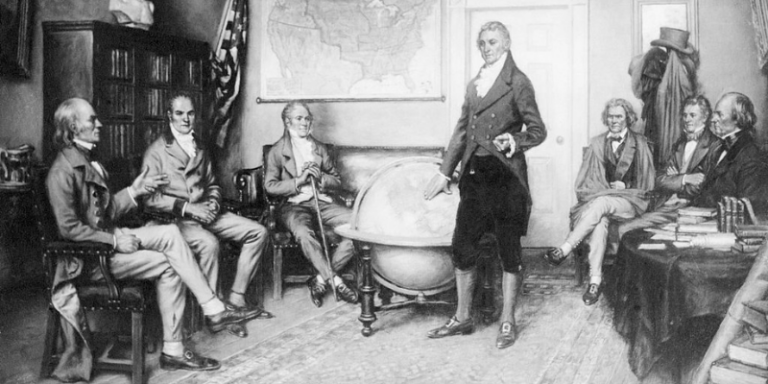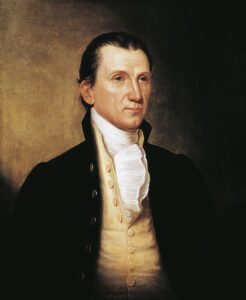James Monroe: Opposing the Federalists
Monroe, Madison, and Jefferson founded the Democratic-Republicans in 1792.
By: Kelli Ballard | May 20, 2025 | 473 Words

Illustration depicting the birth of the Monroe Doctrine. James Monroe is shown standing beside a globe; John Quincy Adams is seated at left. From a painting by Clyde O. DeLand (Getty Images)
James Monroe (1758-1831) was the fifth president of the United States. His presidency saw a lot of changes and the ever-growing contention between the northern and southern states over slavery.
Monroe was born on April 28, 1758, in Westmoreland County, Virginia. At the young age of 16, he attended the College of William and Mary in Williamsburg but dropped out in 1776 to join the Continental Army to fight in the American Revolutionary War for independence from Great Britain. He saw plenty of action in battles in New York, Pennsylvania, and New Jersey, where he was wounded at the Battle of Trenton. He was also with General George Washington at Valley Forge.
Monroe became good friends with Thomas Jefferson and started studying law under him. In 1793, he purchased a farm, Highland, which was located next to Jefferson’s estate, Monticello, in Charlottesville, Virginia.

(Photo by DeAgostini/Getty Images)
After leaving the military, Monroe became involved in politics. He served as a Virginia representative to the Congress of the Confederation from 1781 to 1789. In 1792, James Monroe, James Madison, and Thomas Jefferson joined forces to form the Democratic-Republican Party, which was in opposition to Alexander Hamilton and the Federalists who fought to increase federal power.
President George Washington, in 1794, appointed Monroe as minister to France to try and improve relations between the two countries. He did well, but in November 1794, Jay’s Treaty that regulated commerce and navigation between America and Britain was signed. Monroe opposed the agreement, and he was released from his post in 1796.
He returned to politics in 1799 when President Jefferson asked his help with France. Monroe found out that French leader Napoleon Bonaparte wanted to sell the entire Louisiana Territory for $15 million. Monroe and the U.S. minister to France approved and signed the Louisiana Purchase agreement in 1803, which doubled the size of the United States. Monroe was sworn into office on March 4, 1817, as the fifth president of the United States.
Spain held the territory of Florida, but in 1819, a conflict was brewing between the military, pirates and Native Americans in Georgia. Monroe decided to try and fix the problem. He did so by negotiating the purchase of Florida for $5 million.

Slavery was becoming a serious issue of discussion during Monroe’s time. Missouri wanted to join the Union, but the north wanted to claim it as a free state and the south wanted to claim it as a slave state. Monroe signed what is known as the Missouri Compromise, which allowed Missouri to join the Union as a slave state while Maine joined as a free state. Five states entered the Union during his presidency: Alabama (1819), Illinois (1818), Maine (1820), Mississippi (1817), and Missouri (1821).
Monroe became the third president to pass away. He died on July 4 in 1831, following Thomas Jefferson and John Adams.

















